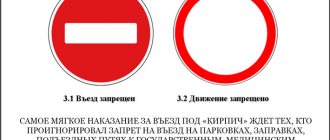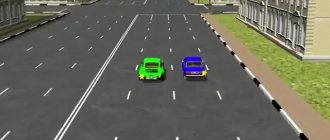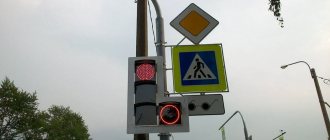Features of the fine for driving under a “brick” in 2021
What does the sign look like? “No Entry” is a red circle with a white rectangle. Because of this rectangle, the sign was nicknamed “brick”.
This is sign 3.1 in the traffic rules. Drivers simply call it "brick"
Sometimes the sign is supplemented with signs:
- validity time - on certain days or hours, for example on weekdays from 8 a.m. to 5 p.m. This means that driving under the sign is prohibited at the specified time.
- with a down arrow - it indicates a lane in which you cannot drive.
The sign means that the sign is valid on weekends from 8:00 to 17:30
The arrow indicates that the sign is valid in a specific lane
Where on the road are signs placed? There is a sign like this at the entrance:
- into the lane with oncoming traffic;
- to a lane for fixed-route transport;
- to the loading and unloading zone of large enterprises;
- in the residential sector next to playgrounds and pedestrian areas.
Who records the violation? This could be a traffic police inspector or a traffic camera. The sign may be accompanied by a “video recording” sign. This means that driving under the sign is recorded by a camera and the driver automatically receives a fine.
If you noticed the sign late and think that you might have received a fine for driving under a “brick” on camera, check it out on “Traffic Police Fines”.
What is the fine for driving under a “no entry” sign in 2021?
If any restriction is violated, a fine is a priori provided. Depending on the effect of the “brick” sign, the traffic rules will change the sanctions against the violator. We suggest considering all situations that can await the driver.
1Adjacent territory. Any car enthusiast drives into a gas station or parking lot. Although this is, of course, not the main road, traffic here is also regulated using markings and signs. The amount of the fine for driving under a “brick” in 2021 in this situation will be 500 rubles.
Failure to comply with the requirements prescribed by road signs or markings of the roadway, except for the cases provided for in parts 2 - 7 of this article and other articles of this chapter (as amended by Federal Laws dated 04/21/2011 N 69-FZ, dated 04/05/2013 N 43 -FZ) entails a warning or the imposition of an administrative fine in the amount of five hundred rubles. (as amended by Federal Law dated July 23, 2013 N 196-FZ)
Part 1 of Article 12.16 of the Code of Administrative Offenses of the Russian Federation
Absolutely any driver can drive under a brick at a gas station, especially if he has never been here before, for example, if he arrived in another city.
2Driving in the opposite direction on a one-way road. One-way traffic on the right side is marked with sign 5.5, but on the other side this section is marked with bricks. Unfortunately, some drivers still don’t know what will happen if they drive under the “brick” sign in this situation, and referring to “maybe”, they drive through. But what is their surprise when, instead of 500 rubles, the traffic police inspector issues a fine of 5,000 rubles or a deprivation of rights for 4 to 6 months.
Driving in the opposite direction on a one-way road entails an administrative fine in the amount of five thousand rubles or deprivation of the right to drive vehicles for a period of four to six months.
Part 3 of Article 12.16 of the Code of Administrative Offenses of the Russian Federation
If you violate this area again, you will face a penalty of 5,000 rubles for driving under a prohibitory sign with a camera or deprivation of your license for one year.
Important!
How much is the traffic police fine for driving under a “brick” in 2021 on a dedicated lane? Here the situation is slightly different, but the 3.1 sign is still used. To understand what the penalty for driving under a brick is - a fine or deprivation in this case, we need to turn to part 1.1 of article 12.17 of the Code of Administrative Offenses of the Russian Federation.
Movement of vehicles along the lane for fixed-route vehicles or stopping on the said lane in violation of the Traffic Rules, except for the cases provided for in parts 3 - 5 of Article 12.15 of this Code, and the case provided for in Part 1.2 of this article (as amended by Federal Laws dated 07/10/2012 N 116-ФЗ, dated 07/23/2013 N 196-ФЗ) entails the imposition of an administrative fine in the amount of one thousand five hundred rubles.
Part 1.1. Article 12.17 of the Code of Administrative Offenses of the Russian Federation
The fine for driving under a brick for federal cities will be twice as high.
The violation provided for in Part 1.1 of this article, committed in the federal city of Moscow or St. Petersburg, entails an administrative fine in the amount of three thousand rubles. (Part 1.2 introduced by Federal Law dated April 21, 2011 N 69-FZ)
Part 1.2 of Article 12.17 of the Code of Administrative Offenses of the Russian Federation
As you can see, driving along a dedicated lane does not deprive of your license, but a fine is imposed for driving under a brick.
What types of fines are provided?
| Violation | Fine | Article of the Administrative Code |
| Driving into oncoming traffic on a one-way road | 5000 rub. or deprivation of rights for up to six months | 12.16 |
| Repeated trip to oncoming traffic in a year | 5000 rub. - from the camera, extra for a year - from the inspector | 12.16 |
| Entry into a closed area | 500 rub. | 12.16 |
| Entrance to the yard | 500 rub. | 12.16 |
| Leaving or stopping in a bus lane | 3000 rub. in Moscow and St. Petersburg, 1500 in the regions | 12.17 |
Whether the driver’s license will be deprived or just fined depends on the court’s decision, and in case of a repeated violation, on the method of recording. When a violation is recorded by a camera, the rights cannot be deprived by law.
Alexander Torvard, auto lawyer The camera only sees the license plate number, but it does not distinguish who is driving. It's not a fact that it's the driver. For example, this could be a person without a license to whom the owner gave the car for a ride. If the driver is caught by an inspector, he sees the whole picture: the license plate number of the car and the real culprit. There is no need to prove that the owner of the car was driving.
Access under a brick to the lane for route vehicles
The marking strip for route vehicles is used for the movement of buses, trolleybuses and other vehicles for similar purposes. Ignoring such rules is regulated by Part 1.1 of Art. 12.17 of the Code of Administrative Offenses of the Russian Federation, which provides for the punishment of a violating driver with a fine equal to 1,500 rubles. For Moscow and St. Petersburg, such ignoring of the sign will cost the driver double the indicated amount (Part 1.2 of Article 12.17 of the Code of Administrative Offenses of the Russian Federation).
Note. Movement under the “brick” on the marking strip for public vehicles is only allowed for buses and minibuses, and is not allowed for taxi drivers and cyclists.
All cases of entry under the “brick” sign (table)
“Brick” is considered the most recognizable sign and is indicated in the group of prohibitory signs. The driver must know the requirements of the “brick” and the exceptions that allow driving under it.
“Brick” ensures that vehicles are prohibited from entering the marked road. Its effect applies both to the prohibition of entry into oncoming one-way traffic, and to the ban on exit to the adjacent territory. In addition, if such a sign is present, you cannot drive onto the median strip for public vehicles.
In a word, sign 3.1 prohibits the movement of any vehicle on a certain road. Finding out “No Entry” is not difficult. It looks like a red circle, against which there is a white rectangle in the center, so you can’t help but pay attention to it. If a driver encounters such a sign on his way, he must look for another route to bypass it.
“Brick” is often used in advertising design, but penalties are imposed only when it is installed:
- On a one-way road.
- In difficult areas where you need to stop or detour.
- On routes serving municipal vehicles.
- At gas stations and parking lots, to separate traffic lanes.
- At the entrance to a road closed to vehicles.
With the installation of DVRs on the streets, it has become more difficult for car drivers to hide their ignorance of “bricks”, which forces them to comply with traffic rules more disciplinedly, so protocols for such illegal acts have been drawn up much less frequently lately. In addition, there is usually a traffic police inspector located not far from this sign. This is also the reason for the decrease in such disregard for traffic rules.
When driving under such a sign, the driver is subject to administrative penalties for failure to comply with traffic rules. The punishment for driving under a brick is not the same and depends on the type of illegal action. Drivers who drive under a sign with oncoming traffic are subject to the highest penalties. At the same time, more lenient legislative norms apply a fine to a driver who drives under a “brick” into a yard or other area adjacent to the street.
Legislative norms establish the following types of liability for movement under such a sign:
- For driving under a “brick” with an oncoming single-lane direction, a penalty of 5,000 rubles or confiscation of driving license for up to 6 months is applied (Article 12.16.3 of the Code of Administrative Offenses of the Russian Federation).
- For slipping “under a brick” into the yard, the penalty will be 500 rubles (Article 12.16.1 of the Code of Administrative Offenses of the Russian Federation).
- For driving in the “brick” zone in lanes for public vehicles, the penalty will be 1,500 rubles (for Moscow and St. Petersburg – 3,000 rubles) (Article 12.17 of the Code of Administrative Offenses of the Russian Federation).
Note. Traffic police patrol officers are often confused about the amount of penalties between different types of violations if the “brick” is not followed, and an inattentive or illiterate driver, instead of 500 rubles, can pay 10 times the amount of the penalty.
Below is a table that clearly shows the amount of the penalty for moving under a “brick” in various circumstances.
In what cases is travel permitted?
For public transport. The sign is not valid only for route transport. Everyone else is prohibited from going.
At the certain time. If there is a sign under the “No Entry” sign with the operating hours, for example, only on weekdays, the rest of the time travel is allowed and there will be no fine.
Entry is limited to some lanes. This is indicated by an additional sign with an arrow to the closed lane. However, the remaining lanes are open.
When is driving under the “brick” sign allowed?
Rules without exceptions most likely do not exist. The “No Entry” sign also has some exceptions that allow some types of vehicles to ignore the established ban. It should be noted that not every driver knows in what cases it is permissible to ignore such a prohibition. Some drivers living in the prohibition zone drive under the “brick”. However, this is not considered a reason for entry and the driver, in this case, may be fined. It all depends on the integrity of the traffic police patrolman or on his mood.
It should also be noted that no traffic circumstances (injury, illness, etc.) can become a valid reason for moving under a “brick”.
Every motorist is obliged to “hack on the nose” - if a “brick” is installed, this means it is forbidden to enter. Such a pointer can only be ignored when moving:
- Buses.
- Minibus.
- Trolleybuses.
- Trams.
Consequently, if the listed transport follows an approved route, on the path of which a “Brick” is installed, it has the right to ignore such a sign. However, for this, the driver is required to have a permit to travel along this route.
With private taxi drivers the situation is more problematic. Ignoring such a prohibition by a taxi driver is usually allowed only when installing an explanatory sign under the “Brick”.
In addition to the listed public vehicles, with permission to drive under a brick, the legislative standards of the Russian Federation provide for other exceptions for ignoring the “brick”. So, for example, you can ignore this pointer:
- Persons driving an emergency vehicle (ambulance, fire truck, police, etc.).
- If the driver is disabled. At the same time, he must have an identification sticker on his car.
- The car owner lives in the area covered by the “brick” sign. At the same time, the driver is required to carry with him a passport confirming his registration in the prohibited zone.
- The person drives a postal vehicle and has permission to enter under a prohibited sign.
- A driver who operates equipment to perform repair services or deliver heavy cargo.
All of the above situations require the presence of a document allowing movement under the “brick”. If a driver from the above list does not have such a document, he can be punished in accordance with the Code of Administrative Offenses of the Russian Federation, along with other car drivers.
How to reduce the penalty for driving under a brick
The most effective way to reduce the amount of a fine for moving under a “brick” is to pay off the fine within 20 days from the date it was assigned. If the fine is repaid within the specified period, its amount is reduced by half (Part 1.3 of Article 32.2 of the Code of Administrative Offenses of the Russian Federation).
You can also reduce the amount of the penalty:
- If on the one-way area where the “brick” hangs, there are no signs for the beginning and end of one-way movement. In this option, you can persuade the traffic police patrolman to come to a compromise solution by reclassifying the offense.
- The next way to influence a traffic police patrolman that can be used is to point out to the driver a positive driving history. Part 1 art. 12.16 of the Code of Administrative Offenses of the Russian Federation provides that a traffic police officer can issue a warning if traffic rules are ignored by a respectable driver who has not previously been subject to administrative penalties. In this option, you can only hope for the favor of the patrolman.
How to appeal a fine for driving under a “brick”
Appeal procedure. The law gives 10 days to appeal the fine from the date of the decision. The date of the decision can be seen on the document itself if the letter from the traffic police arrived by mail.
To avoid going to the post office and standing in line, check the date on the Traffic Police Fines website:
If there is a fine, the date will be above the name of the fine
What to write in a complaint. In the document please indicate:
- the position and name of the head of the traffic police department is indicated in the resolution;
- applicant's passport details and telephone number;
- the essence of the complaint - the circumstances and arguments for reversing the decision;
- list of additional documents - copies of the decree and documents for the car.
Sample complaint. , change the data and send it to the traffic police.
This is a complaint about a fine from a camera. TsAFAP is a center for receiving and processing camera recordings
Can you deprive your license for driving under a “brick”?
Yes, if the driver entered a one-way road with oncoming traffic.
The decision on deprivation of rights is made by a judge - the traffic police inspector can only look at the history of violations. The inspector will send the case to court. The judge will take into account all previous violations of the driver, his testimony and make a decision.
At trial, the driver can tell something that the traffic police officer did not take into account when viewing photo and video materials. This could be due to poor visibility due to weather conditions or the fact that the sign was lying on the ground in the first place.
Cameras record the passage to the brick
If a violation of the requirements of sign 3.1 occurred in a situation where the punishment for the violator is deprivation of rights, then a protocol must be drawn up (see Part 1 of Article 28.6 of the Code of Administrative Offenses of the Russian Federation). However, the reasonable position of the driver should be this: before signing a resolution on an administrative offense or a protocol, it would be correct to determine the degree of his own guilt.
Comprehensive information on the “brick” road sign can be found in the official driver’s regulations of the Russian Federation (SDA). An element implying a restriction on travel may be located in the driver’s path in certain situations. Each of the options is regulated by the State Standard, which provides legal ways to impose a fine for ignoring it. When you can see a “brick” sign - 5 typical situations: The road route is used only by route transport - buses, trams, taxis and so on. Then the road the element prohibits the passage of motor vehicles along the road lane on which minibuses move. When the driver encounters a road surface on which it is possible to move only in one direction. If the movement of vehicles is two-way, a “brick” is placed on both sides at once sides of the road to maximize the safety of traffic flow through the area.
We recommend reading: How to take into account penalties when settling
Remember
- The “brick” sign is placed in front of oncoming traffic lanes or to free up a lane for fixed-route traffic. The sign is also located in the loading zone of enterprises and near pedestrian areas.
- Only public transport is allowed to pass under the sign on the lane.
- It happens that the passage is closed at certain times, for example, during the day on weekdays. This information is explained by a sign under the sign.
- If the arrow on the sign points to a specific lane, entry to it is closed.
- The sanction for driving under a brick is from 500 rubles. to imprisonment for 6 months.
- Such violations are recorded by cameras and traffic police inspectors.
- To appeal a fine, within 10 days from the date of the decision, file a complaint with the head of the inspector who issued the fine.
All articles by the author: Evgeniy Lesnov
Additional conditions for punishment for a brick
Not all drivers know that a brick fine can be canceled if a number of conditions regarding its location are not met.
Additional conditions for travel to a brick fine 2021 include:
- A one-lane road with oncoming traffic must be marked with the signs: Beginning of a one-way road, End of a one-way road;
- At exits from adjacent areas onto a one-lane road there should be a sign for Entry onto a one-way road;
- Signs must be located to the right of the roadway or above the road, unless otherwise specified;
- The sign must be visible from a distance of 100 m.
Therefore, if the location of the sign does not provide for its absolute visibility, the driver may be exempt from sanctions or their size must be changed: what fine you will have to pay for a brick depends on what and where this brick was.
An important point is the possibility of appealing a fine.
How can you appeal a fine for driving under a brick?
The right to appeal a decision is possible if:
- File an appeal within 10 days;
- If your offense is overestimated by the inspector, you can make a note of disagreement on the protocol, since you did not see this sign and why you did not notice it.










